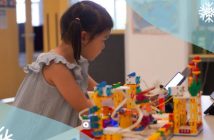There are many myths about raising a child with more than one language. Parents are told that it can lead to confusion, speech delays or that they have missed a window of opportunity. However, a lot of research has been conducted on the topic and the results show that babies are wired for language.
There are many reasons why it is beneficial to raise bilingual children. Babies who grow up listening to two languages are said to have better problem solving skills, increased memory power and heightened sensitivity to sound and visual cues – all this even before they can talk!

Experts also say that growing up in a bilingual environment not only shapes language development, but also cognitive development. In fact it has been proven that bilingual babies get bored more quickly when they are repeatedly shown the same picture, and have a greater thirst for new images– tendencies which have strong links to higher IQ and greater creativity, later in life.
Knowing a second (or third!) language could one day give your child an edge in an increasingly global workforce. You may also want your child to grow up knowing his or her native language so that they can be more in touch with their roots. If you are considering raising your baby with more than one language, take a look at these common questions and answers to help your little linguist start learning.

1. If Parents Speak Different Languages, Does the Child Automatically Learn Both Languages?
Not necessarily. For the best chances of success in bringing up a bilingual child, you need to plan ahead. How fluent do you want your child to be and which would be the dominant language? You also need to look into how much exposure your child gets to each language.
2. What is the Right Time to Start Teaching a Second Language to a Child?
The earlier, the better. Even baby-talking with your infant may boost his or her ability to learn. Although the real learning occurs around the age of two or three when children start to expand their vocabulary, it is said that exposure to different language sounds starting from six to 11 months may make it easier for the child to pick up unique sounds and recognize them when they are two or three years old. Having said that, it is never too late to teach your child a new language.
3. What if the Child Mixes Up the Two Languages?
Bilingual children sometimes mix the two languages or may answer you in the “wrong” language. This is inevitable and harmless. You might think that they cannot tell the languages apart, but studies show that babies start to figure out the difference at six to eight months of age. Eventually as the child develops his or her vocabulary, they stop mixing the languages.

4. How Can We Create a Multilingual Environment for our Child?
The best way for a child to learn a new language is for them to hear people speaking it fluently. Create a casual learning environment and try the “one person, one language” approach where one adult speaks only the second language, so that the child doesn’t get only bits and pieces of it. You can also use tools such as bilingual picture books, toys, games, television programs and so on. As the children learn new words in the primary language, it is helpful to tell them what they’re called in a second language.
5. How Can Monolingual Parents Raise a Bilingual Child?
If you’d like to raise your child to be bilingual, you’ll have to show them that the second language is worth learning!
• Start by teaching yourself some vocabulary, nouns especially and simple phrases.
• Let your child become familiar with these words. Once the words are familiar and recognized, the child will then have a much easier time understanding them in context with a fluent speaker.
• You can try the immersion technique by enrolling your child in a school where the second language is used predominantly.
• Buy books and have the child watch videos in that language. Eat at restaurants that specialize in the foods of that culture.
• If you are hiring baby-sitters or nannies, it would be beneficial to hire someone who can fluently speak the second language.
Photos: Submitted by Sanfine International Hospital




